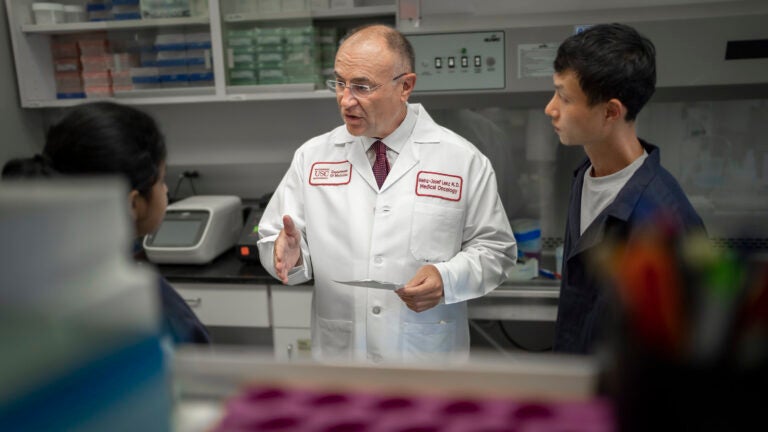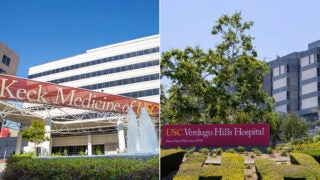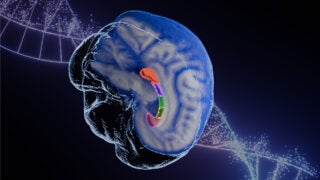
Heinz-Josef Lenz, center, talks with postdoctoral scholar Pooja Mittal, left, and research technician Jae Ho Lo. (Photo/Chris Shinn)
USC researchers pioneer lifesaving cancer breakthroughs
From research lab to hospital bedside, USC’s culture of innovation fosters groundbreaking approaches to the detection, treatment and prevention of cancer.
Several years ago, Heinz-Josef Lenz, a professor of medicine and cancer biology at the Keck School of Medicine of USC and the J. Terrence Lanni Chair in Gastrointestinal Cancer Research, made a surprising discovery about colon cancer. He and his research team found that circadian rhythm — the body’s internal clock — influences the effectiveness of colon cancer treatments including immunotherapy and targeted antibodies.
Wondering if the circadian clock could be a new key to fighting colon cancer, Lenz set out to learn more about this regulator of sleep-wake cycles. He soon realized that one of the world’s foremost experts on the circadian clock, Steve Kay, was a fellow faculty member at the Keck School of Medicine.
Though Kay — University and Provost Professor of Neurology, Biomedical Engineering and Quantitative and Computational Biology; the David L. Lee and Simon Ramo Chair in Health Science and Technology; and director of Convergent Bioscience — had no expertise in colon cancer, he was excited when Lenz reached out to collaborate. The two researchers’ labs began a robust exchange of knowledge.

“What we found is that some circadian clock proteins our lab has been researching for many years are the ‘gas pedal’ to cancer,” Kay said. “Out of that came a whole set of experiments that started to really blow all of us away. Drugs that my lab developed to target the circadian clock showed they could kill colorectal cancer cells.”
Lenz and Kay are among an array of USC researchers making lifesaving breakthroughs in cancer treatment, prevention and detection with out-of-the-box thinking, trailblazing technology and cross-disciplinary collaboration. Their partnership, like so many others at USC, emerged from the university’s unique research ecosystem, which laid the groundwork for their success.
A culture of innovation
The two researchers embody the extensive range of cancer-fighting expertise represented across USC’s health sciences schools, centers and hospitals. These include the Keck School of Medicine, the Keck Medicine of USC health system, the USC Norris Comprehensive Cancer Center and USC Norris Cancer Hospital, the USC Alfred E. Mann School of Pharmacy and Pharmaceutical Sciences, the USC Leonard Davis School of Gerontology, and Children’s Hospital Los Angeles, among others. Frequent collaborators include scientists at the USC Viterbi School of Engineering and the USC Dornsife College of Letters, Arts and Sciences.
A universitywide emphasis on translational research (moving findings from the lab into practical applications) and convergent science (bringing together experts from divergent fields to tackle complex problems) nurtures a culture of innovation. The Translation and Clinical Sciences Program at the USC Norris cancer center, for example, unites researchers from five schools and 18 departments to discover and develop innovative treatments and biomarkers to improve clinical outcomes for cancer patients.
“The beauty of our health sciences schools and services is that we have assembled some of the greatest experts in the nation dedicated to preventing and treating cancer,” said Steven Shapiro, USC senior vice president for health affairs. “With the breadth and depth of our talent and scientific research, combined with our passion for discovery, we will continue to foster cancer breakthroughs that will benefit our patients, community and the world.”
Lenz and Kay jump-started their colon cancer research with a grant from the USC Norris cancer center and later expanded their work to breast cancer and liver cancer. A 2023 study by Kay, Lenz and their collaborators showed how liver cancer cells hijack circadian clock machinery to divide and spread. The work also informed Kay’s development of a circadian clock-targeting compound for glioblastoma, a deadly form of brain cancer — the first compound of its kind shown to be safe and effective in humans. A clock-targeting drug for colon cancer is in the works. The researchers are collaborating with Synchronicity Pharma Inc., a biotechnology company Kay founded, to make these compounds commercially available.
Read on to learn about more pioneering cancer breakthroughs from USC researchers.
Beating brain tumors with electrical impulses
Wearing a cap outfitted with electrodes to treat brain cancer may sound like something out of a science fiction film. But a research team led by USC’s David Tran has discovered that such a device — known as Tumor Treating Fields (TTFields) — may offer new hope to glioblastoma patients.
According to the National Brain Tumor Society, the median survival for patients diagnosed with glioblastoma — a highly aggressive and difficult-to-treat brain tumor — is eight months. A recent study by Tran and his colleagues showed that combining chemotherapy and immunotherapy with TTFields is associated with a 70% increase in overall survival.
TTFields therapy delivers targeted waves of electrical fields directly into glioblastoma tumors through electrodes strategically positioned on the scalp. Low-intensity alternating electric fields push and pull key structures inside tumor cells in continually shifting directions.
“The TTFields device creates an environment inside tumor cells that mimics viral infection,” said Tran, associate professor of neurological surgery and neurology at the Keck School of Medicine, chief of neuro-oncology at Keck Medicine of USC and co-director of the USC Brain Tumor Center. Tran has been studying the therapy for more than a decade.
These cellular changes trigger a potent immune response within the tumor, circumventing the tumor’s typical defenses against the body’s immune activity. Adding immunotherapy prevents the tumor from turning off that immune reaction. “The immune system actually does the job of killing the tumor, which shrinks incrementally over time,” Tran said.
Notably, patients in the study with large, inoperable tumors lived even longer than those who had undergone surgical removal of their tumors. “The bulkier the tumor,” Tran said, “the more material there is for an immune response” — a hopeful finding for patients whose tumors extend into highly critical regions of the brain, making surgical removal risky.
Tran is now leading a large international clinical trial in newly diagnosed glioblastoma to validate the effectiveness of TTFields with immunotherapy and chemotherapy.
A cancer-fighting compound from the ocean floor
Chemotherapy, a standard treatment for cancer, does kill cancer cells. But it can also damage healthy cells in tissues like skin and hair where cells are continually growing and dividing, causing serious and sometimes long-term side effects.

A groundbreaking study co-authored by Ryo Sanabria, an assistant professor of gerontology at the USC Leonard Davis School, has identified a molecule that shows promise as a cancer therapeutic that may protect healthy cells while destroying malignant ones. The molecule, called mycothiazole (MTZ), hails from an unusual source: sea sponges that live in deep ocean waters.
Sanabria and Naibedya Dutta, a postdoctoral fellow in the Sanabria Lab, collaborated with chemist and deep-sea diver Tyler Johnson, an associate professor of chemistry at Dominican University of California, to study MTZ’s effects on human cells. When they applied MTZ to a variety of human cancer cells — including liver carcinoma, breast cancer and glioblastoma — the molecule hindered the cells’ ability to make energy. Up to 80% of the cancerous cells treated with MTZ died.
Yet when MTZ was applied to healthy, non-cancerous cells, the molecule had little effect. “It was shocking,” Sanabria said. “Usually, when you put any kind of drug on any kind of cell, you see at least a handful of gene expression changes. But in healthy cells, we saw none.”
The research team also tested a synthetic form of MTZ called 8-O-acetylmycothiazole (8-OAc), which yielded similar results. 8-OAc has a much longer shelf life than MTZ, making it potentially more suitable for clinical use. Next steps include testing the molecules in mouse models and human subjects.
A blood test for diagnosing ovarian cancer
Many cancers, such as breast cancer and skin cancer, are diagnosed with a tissue biopsy, in which a small sample of tissue is extracted with a needle. One exception is high-grade serous ovarian carcinoma (HGSOC), the most common type of ovarian cancer.
Biopsy of a pelvic mass is considered too risky because inserting a needle deep into the pelvis may damage critical organs and spread cancer cells into the abdominal cavity. Doctors typically perform surgery when they suspect HGSOC to remove a pelvic mass in its entirety. Yet invasive surgery comes with risks of its own, and studies indicate that the vast majority of these masses turn out to be benign.
Bodour Salhia — associate professor of cancer biology at the Keck School of Medicine, the Royce and Mary Trotter Chair in Cancer Research, and interim chair of the department of cancer biology — and her collaborators have developed a simple blood test, or “liquid biopsy,” for HGSOC that may help screen for the cancer in its early stages and spare thousands of women from unnecessary surgery.
The test is based on Salhia’s research on cell-free DNA methylation. Methylation is a complex modification of DNA that can affect the way genes are expressed in the body. “Cancer cells have altered DNA methylation profiles that we can pick up in the blood,” Salhia said.
Salhia worked closely with Lynda Diane Roman, associate professor of obstetrics and gynecology and division chief of gynecologic oncology at the Keck School of Medicine, and other USC Norris cancer center collaborators to translate her genomics research into a test that could fill a clinical gap in the diagnosis and treatment of HGSOC. A recent study by Salhia, Roman and their collaborators shows that the blood test, known as OvaPrint, determines whether a pelvic mass is benign or cancerous with up to 91% accuracy.
OvaPrint will become commercially available later this year through the biotechnology company Salhia founded, CpG Diagnostics Inc.
Fasting to augment cancer treatment
Eating a healthy diet rich in fruits, vegetables, beans and other plant foods can help lower the risk of cancer. But research by Valter Longo, professor of gerontology and biological sciences at the USC Leonard Davis School and the Edna M. Jones Chair in Gerontology, and his collaborators has shown that limiting food for short periods of time can be a powerful weapon in the fight against cancer, too.

For nearly two decades, Longo’s lab has studied how fasting and the “fasting-mimicking diet” (FMD) — a low-calorie, plant-based diet that simulates fasting for five days — affect cancer in mice. He’s learned that fasting and FMD lead to cellular and metabolic changes that promote cancer prevention and treatment. They create weaknesses in cancer cells that can be exploited by drugs, render cancer therapies like chemotherapy and immunotherapy more powerful and protect healthy cells from the toxicity of such therapies.
One of Longo’s recent findings, in collaboration with the IFOM Cancer Institute in Milan, is that FMD becomes even more effective at treating some types of cancer in mice when combined with vitamin C. The combination of FMD plus vitamin C works to kill cancer cells by causing the body to produce an excess of reactive oxygen species, molecules that at high levels lead to cell death. Earlier research by Longo’s team showed that FMD combined with chemotherapy increases attacks on cancer cells by the immune system.
Another recent study found that FMD enhances the tumor-fighting effects of cancer hormone drugs on breast cancer in mice and delays drug resistance. Clinical trials suggest that FMD may have similar effects in women with breast cancer. Several trials in humans are now investigating the effects of FMD in combination with different cancer-fighting drugs, with promising early results.
“I like to call FMD the nontoxic wild card for cancer treatment,” Longo said. He is working toward a day when cancer will be treated with low-toxicity “cocktails” such as FMD with vitamin C that kill cancerous cells but spare normal ones.
Longo’s discoveries have been leveraged by his company L-Nutra to create FMD kits for general health and tailored to specific diseases including cancer, diabetes and Alzheimer’s.
Novel therapies for prostate cancer preserve quality of life
For men with intermediate-risk prostate cancer confined to the prostate, surgery and radiation are effective treatments, but they introduce the risk of undesirable side effects, including impotence, urinary incontinence and bowel dysfunction.
Researchers at USC Urology and the Keck School of Medicine are transforming prostate cancer care with cutting-edge focal therapy. These techniques eliminate only the parts of the prostate that contain the cancer cells rather than removing the entire prostate, minimizing side effects and preserving patients’ quality of life.
Andre Abreu, associate professor of clinical urology and radiology, and Inderbir S. Gill — chairman and Distinguished Professor of Urology, the Shirley and Donald Skinner Chair in Urologic Cancer Surgery, and executive director USC Institute of Urology — led a research team that was the first in an academic center in the United States to study focal high-intensity focused ultrasound ablation of the prostate as a primary treatment for prostate cancer following FDA approval of the therapy. The procedure, which uses ultrasonic waves to heat up and destroy prostate cancer tissue, demonstrated a high rate of success and low risk of impotence and incontinence.
“Focal therapy is increasingly going to be the preferred treatment for men with organ-confined, intermediate-risk prostate cancer,” Gill said. Other focal therapy techniques offered at USC Urology include irreversible electroporation, which removes cancer with short electrical pulses, and cryotherapy, which targets and destroys prostate cancer cells using very cold temperatures.
Currently, Abreu, who is also the director of image-guided surgery, focal therapy and artificial intelligence for prostate cancer for Keck Medicine of USC, is the site leader of a national clinical trial evaluating a water vapor system that uses targeted amounts of steam to destroy prostate tumors. Gill and Mihir Desai, professor of clinical urology, are pioneering Aquablation, a novel robotic, high-pressure, high-precision water-jet device to remove prostate cancer cells from within the urethra. As global co-principal investigators, they are leading an international, FDA-approved investigational device exempt (IDE), prospective randomized clinical trial in 280 men comparing Aquablation versus robotic radical prostatectomy surgery, the current standard.
“At USC Urology, innovation is our mantra,” Gill said.
Featured Experts
Heinz-Josef Lenz
Expert in gastrointestinal cancer, including esophagus, stomach, colorectal and gastric cancer, genetic predisposition to colorectal cancer, the molecular biology of cancer, cancer genetics and pharmacogenetics — how genes influence the effectiveness of drugs
Steve Kay
Expert in circadian rhythms in plants and mammals, circadian clock, chronobiology, biological rhythms, biological clock, body clock, day-night cycle, clock genes, peak times, circadian transcriptional networks, sleep-wake cycle, evolution of circadian clock, biochemistry, neurology, physiology and biophysics
Lynda Diane Roman
Expert in gynecologic oncology, cervical cancer in pregnancy, ovarian cancer, uterine cancer, vulvar cancer and hysterectomy in the presence ofinvasive cervical cancer
Valter D. Longo
Expert in the mechanisms and genetics of aging, healthy aging, the biochemistry of aging and age-related diseases, the oxidative biochemistry of Alzheimer’s disease, oxidative damage and aging and the role of glucose/nutrients in the regulation of longevity



